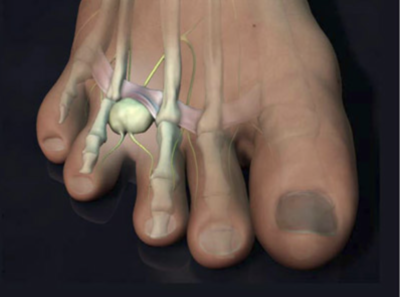
“Every nerve that can thrill with pleasure, can also agonize with pain.”
– Horace Mann
Morton’s Neuroma
Morton’s Neuroma is a painful condition of the forefoot, ten times more likely in women, with a mean age of presentation around 50 years of age. Morton’s Neuroma is a compression neuropathy, more specifically a compression injury to the common digital branches of the medial and/or lateral plantar nerves in the inter-metatarsal spaces. It is thought to be a result of trauma, malformation, infection or an overgrowth of vasculature/axons.
It is recommended to first read the following sections to become familiarized with some of the terms and concepts related here:
See also, medications for nerve pain:
Gabapentin (Neurontin) & Pregabalin (Lyrica)
Definitions and Terms Related to Pain
Key to Links:
Grey text – handout
Red text – another page on this website
Blue text – Journal publication
.
Morton’s Neuroma
A neuroma is a mass composed chiefly of nerve fibers and nerve cells characterized by nodular thickening, axonal demyelination and fibrosis of the nerves and associated degenerative vascular changes.
The following information has been gleaned from conference lectures. This section is incomplete and more information will be added soon…
Symptoms
- Onset of forefoot pain that is often gradual and insidious
- Aggravated by tight fitting shoes in the forefoot
- Aggravated by activity
- Characterized by stabbing, cramping, burning, aching, knawing pain
- Feels like “sock rolled up under the foot” or like there is a “lump there”.
- Adjacent toes may tingle or feel numb
Physical Examination Findings
- No pain/effusion otherwise on musculoskeletal exam
- Absence of other neurologic findings (tarsal tunnel, soleal sling, straight leg raise, etc)
- Positive Mulders sign – defined as a palpable “click” that reproduces the described pain when performing this maneuver. However, a palpable “click” may be elicited without any pain – one must rule out other possible causes of forefoot pain in that case.
Imaging
X-ray:
Neuromas will not be seen but one may see slight splaying of the toes adjacent to the area of pain
Diagnostic Ultrasound:
Neuromas likely to be seen but will be difficult to identify if small (< 6mm lesions)
Potential false positives: 54% asymptomatic patients were found to have sonographic nerve thickening
MRI:
The MRI may be most useful for identifying neuromas > 5mm
Potential false positives: 33% of asymptomatic patients demonstrated the presence of a mass on MRI.
Nerve Conduction Studies (NCS):
NCS may offer an alternative diagnostic method
Differential Diagnoses
- Arthralgia
- Ligament injury – plantar plate injury
- Tendon injury
- Biomechanical causes – ankle equinus
- Proximal nerve injuries – tarsal tunnel, soleal sling
- Fractures
- Neoplasms
Treatment
Medical Management
Accommodative shoes, including padding: May improve symptoms in up to 41% of patients
Oral Anti-inflammatories (NSAIDs): May offer relief for mild to moderate pain
Gabapentin (Neurontin) & Pregabalin (Lyrica)
CAM Treatment for Nerve Pain:
NRF2 activators including: Curcumin and Quercetin
NMDA Antagonists – Dextromethorphan
Interventional Management
Steroids Injections (Betamethasone/xylocaine):
4 years follow-up:
Average number of injections: 1-4
28%-53% had resolution of symptoms
17-47% progression to surgery
Botox: 70% experience reduced pain
Alcohol sclerosing injections:
Abandoned by many as ineffective
29%-84% symptom free
30% had return of symptoms
35.5% required surgery
Radiofrequency ablation: 18-83% reported complete symptom relief
Surgical Management
Decompression only:
Open, Minimally invasive, Endoscopic
Preservation of nerve function
No stump neuroma – paresthesiae
84% good/excellent
3.6 – 8.7% required subsequent neurectomy
Metatarsal osteotomies (Longest of adjacent metatarsals is shortened)
Decompression + osteotomy: 96% good/excellent
Neurectomy (Excision) with or without replantation:
70% restrictions in footwear 4 years post op
51-82% of patients have long term paresthesias
Follow up 10 years: 4.8% residual pain
“There is no other human chronic nerve compression syndrome in which the treatment recommended is resection of the nerve with expected loss of its function.”
References:
Morton’s Neuroma – Overviews
Emphasis on Education
Accurate Clinic promotes patient education as the foundation of it’s medical care. In Dr. Ehlenberger’s integrative approach to patient care, including conventional and complementary and alternative medical (CAM) treatments, he may encourage or provide advice about the use of supplements. However, the specifics of choice of supplement, dosing and duration of treatment should be individualized through discussion with Dr. Ehlenberger. The following information and reference articles are presented to provide the reader with some of the latest research to facilitate evidence-based, informed decisions regarding the use of conventional as well as CAM treatments.
For medical-legal reasons, access to these links is limited to patients enrolled in an Accurate Clinic medical program.
Should you wish more information regarding any of the subjects listed – or not listed – here, please contact Dr. Ehlenberger. He has literally thousands of published articles to share on hundreds of topics associated with pain management, weight loss, nutrition, addiction recovery and emergency medicine. It would take years for you to read them, as it did him.
For more information, please contact Accurate Clinic.
Supplements recommended by Dr. Ehlenberger may be purchased commercially online or at Accurate Clinic.
Please read about our statement regarding the sale of products recommended by Dr. Ehlenberger.
Accurate Supplement Prices
.
